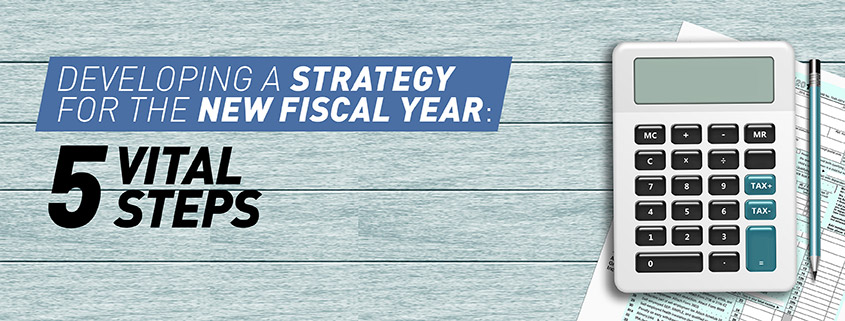Christmas in July? For nonprofits, it kind of is! In June, most nonprofits reach the end of their fiscal year. This means July brings another new beginning.
While the end of the calendar year brings the promise of higher donations due to boosted end-of-year giving, the end of the fiscal year brings hope for another prosperous financial year. It’s a time to celebrate and get excited about all your upcoming ideas and activities.
After you’ve turned in your Form 990 and other paperwork, you can start planning another exciting year for your nonprofit!
Developing a strategy for the year to come is an incredibly important step to make this next year the best it can possibly be. Some of the crucial steps to include in this strategy are:
- Create an annual report.
- Make a wish list.
- Budget accordingly.
- Share about matching gifts.
- Consider potential in-person events.
Let’s dive in so your nonprofit can get started building your new strategy!

1. Create An Annual Report
An annual report is when you have the chance to display everything you did in the last year. You should discuss the projects you completed, your impact on the community, and any statistics you have for your organization’s actions.
Now’s not the time to be humble! Show off everything you’ve accomplished. You deserve to be proud of it.
Your annual report is like your donor recognition wall, except for yourself. You have the chance to celebrate year after year, comparing your evolving annual reports to see how your accomplishments have changed and grown.
While this report is mostly for the benefit of your donors (and tax authorities), it has multiple functions including:
- Providing an updated report to your donors. Make the report donor-driven. Tell them what they’ve accomplished in order to boost their moral. An annual report confirms to donors that their support has gone to a good cause.
- Boosting moral inside the nonprofit. Listing out all your accomplishments and everything you’ve done over the last year also helps you! You and your team should feel proud of this report and everything in it. Let it fuel you for the year to come.
- Showing areas of improvement. While you are discussing the accomplishments of the last year, keep an eye out for those things you could have done better. Host a post-mortem meeting after celebrating the accomplishments to focus on improving these.
- Calling to action. Call your donors to action. Let them know that while last year was great, this year could be even better! Tell them how they can continue their support for your organization.
Send this annual report out to your donors to celebrate their hard work last year and to call them to continue the good work this year.

2. Make A Wish List
A wish list will help you keep your ideas in order for the upcoming year. It keeps you on track for all those things your organization would like to accomplish.
The steps you should take when putting this list together are:
- Brainstorm. Brainstorming includes all wish list ideas, no matter how plausible. Write down each and every idea that your organization would like to see accomplished. From even the craziest ideas, actionable new ones might pop up.
- Filter. At this stage in the process, you want to filter out all those ideas that will be absolutely impossible within the next year. But don’t lose sight in those dreams! Tuck them away somewhere so you can come back another time.
- Prioritize. Prioritize which items are the most important to accomplish this year. Your top goals will be accomplished first, then set a goal for how many other items on the list you would like to get done.
While the brainstorm phase might seem a bit silly at first, it can also draw out some long-term goals. While these things may not be possible to accomplish in a single year, this exercise gives you the opportunity to break down that large goal into smaller ones.
Smaller goals are easier to handle, and maybe you can get some headway toward the larger project.
We recommend you create a long-term board where you put long-term goals and remember what you are working toward.
Once you have put together these lists of goals, it will be time to take a peek into your annual fund.

3. Budget Accordingly
Now that you have the list of things you would like to accomplish this year, it is time to budget for them.
The first steps to take to prepare this budget are:
- Examine last year’s budget. Did it seem accurate? See how close you were to hitting your budget maximum and minimums for everything you did. Do you need to make adjustments?
- Pay attention to past fundraisers. Past fundraisers can give you an insight to how much you can expect to raise this year with similar fundraisers. Of course you would love to increase this amount, but make sure you are realistic with fundraising goals.
- Use last year’s budget as an example. Using last year’s budget as a template, see how many of the activities on your wish list you would have been able to accomplish.
Your budget should be created based on your comfort levels. If you are comfortable pushing your budget a little further, then push it further. However, if you are not, or if you expect this year to be more difficult, stay in your comfort zone.
If you are not sure about this whole budgeting process, hire a nonprofit consultant to help!
A nonprofit consultant can help you come up with budgeting and fundraising campaigns to continue to raise funds for your organization.
Depending on where you hire from, different nonprofit consultants offer different functions. Consider your needs before you hire a consultant, and make sure your hire will do everything your nonprofit needs.
Don’t forget to factor the fees of the consultant into your budget. Consider the nonprofit consultant fees guide by Averill Fundraising Solutions to direct your choice.

4. Share About Matching Gifts
Whether you are working alone or with a nonprofit fundraising consultant, your next step will be to consider how you will raise money to complete the items on your wish list.
Brainstorm unique fundraising ideas that will help you raise money throughout the next year.
In addition to these fundraising ideas, tell your supporters about matching gifts. Matching gifts will help you maximize the donation amount you receive from each donor.
Matching gifts are corporate philanthropy programs in which companies match a portion (or the entirety!) of donations given to nonprofits from their employees.
However, many people don’t even realize they are eligible! Marketing matching gifts opportunities informs your supporters about these programs and makes it more likely they will check to see if they are eligible.
To make it even easier to check eligibility, provide a matching gifts database search tool on your website. This way, donors can see if they are eligible in 3 easy steps:
- Type the employer’s name in the database.
- Read about the parameters for the donation.
- Follow a link to the application page.
The matching gifts database by Double the Donation can be integrated directly on your donation page to make sure donors check eligibility before donating.
Work matching gifts into your fundraising strategy for this coming fiscal year. It is an easy way to increase your donation size without asking for any additional donations.

5. Consider Potential In-Person Events
The events you host, whether fundraising events or stewardship events, are vital for building your relationships with your donors.
When you are going over your annual report from the last fiscal year, consider which events were great successes, and maybe some that were not quite so successful.
Do you have any annually occurring events? Try planning one of your most successful events again and making it an annual celebration!
Planning annual events is a great way to get people excited to get involved in your organization. When they remember how much fun an event was last year, they are more likely to also attend this year.
If you are starting from scratch, here are some fun ideas to get you started:
- Concerts.
- Restaurant giving nights.
- Charity auctions.
- A gala.
- Barbeque cookoffs.
Consider the events you would like to hold this year. Are they fundraising events? Stewardship events? Annual? One-time? Consider your organization’s specific needs for each event you want to host, then begin the planning process.
Make this fiscal year a success! Using these five smart steps, your nonprofit will have an organized plan with which you can jump into this next year.



